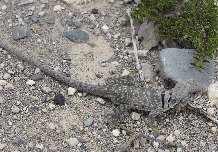Western Collared Lizard (Crotaphytus collaris baileyi)
Description: Western collared lizards are named for the distinctive dark bands that circle the necks of both sexes. Apart from this collar, males and females generally look very different. Males often are bright green, yellow, orange or tan peppered with white spots, and females have a much more muted version of this color scheme. However, during breeding season females develop bright orange spots or bars along their sides. Western collared lizards tend to have large heads, slender bodies and long tails. Including the tail, these lizards measure approximately 8 to 14 inches as adults.
Habitat: These lizards are found in a wide variety of habitats including sagebrush, desertscrub, pinyon-juniper and desert grasslands. They prefer the rocky areas of these habitats as well as areas with open vegetation.
Range: Throughout parts of Colorado and New Mexico.
Found in these States:
CO |
NM
Diet: Not only do they eat insects such as grasshoppers and crickets, but they also eat other lizards, including other collared lizards!
Reproduction: Eggs laying occurs in June-July in Kansas, mainly May-June in west-central Texas. Clutch size usually is 4-11. Reproductive females produce a single clutch annually in the northern part of the range, often 2 clutches in the south. Young-of-year first appear in early August in Missouri and Colorado. Individuals become sexually mature in their 1st or 2nd year (1st year in areas with long growing season). In Oklahoma, males established all-purpose territories (and presumably became reproductively active) when they were two years old. When the female lizard is carrying eggs, she develops bright red splotches of color on her body. This color will disappear after she has laid the eggs.
Status: Crotaphytus collaris is assessed as Least Concern because this species is widely distributed and is represented by many stable populations. It faces no major threats at present.
»» Kingdom: Animalia - Animals
»» Phylum: Chordata - Chordates
»» Subphylum: Vertebrata - Vertebrates
»» Class: Reptilia - Reptiles
»» Order: Squamata - Lizards
»» Family: Crotaphytidae - Collarded & Leopard Lizards
»» Genus: Crotaphytus
»» Species: Crotaphytus collaris - Common Collared Lizard
»» Subspecies: Crotaphytus collaris baileyi - Western Collared Lizard
This article uses material from the Wikipedia article "Common Collared Lizard", which is released under the Creative Commons Attribution-Share-Alike License 3.0. Content may have been omitted from the original, but no content has been changed or extended.
|








